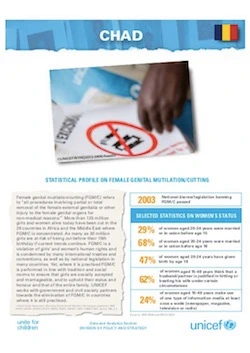Home | Research & Resources | Chad
Key Findings
The prevalence of FGM/C in Chad among women aged 15–49 is 38.4%.
45.1% of women aged 15–49 believe that FGM/C should not continue.
Geography
The regions with the highest prevalence are in the south-east; the regions with the lowest in the north-west
Age
46.7% of women aged 15–49 who have undergone FGM/C were cut between the ages of 5 and 9
Type
The types of FGM/C ‘cut, no flesh removed’ and ‘cut, flesh removed’ are practised in almost equal measures
Agent
Almost all FGM/C is carried out by traditional cutters
Distribution of FGM/C across Chad
FGM/C prevalence varies widely across Chad. The regions with the highest prevalence are in the south-east: Salamat (96.1% of women aged 15–49), Sila (93.2%) and Guéra (90%). The regions with the lowest prevalence are in the north-west: Lac (0.7%), Kanem (0.7%) and Bourkou/Tibesti (1.8%). Unusually, women aged 15-49 who live in urban areas are more likely to undergo FGM/C (40.1%) than those who live in rural areas (37.9%). Prevalence in the capital city of N’Djaména is 37.6% of women aged 15–49.
The prevalence of FGM/C among Muslim women aged 15–49 is 50.4%, compared to 40.1% for Catholics and 14.9% for Protestants.
The ethnic group with the highest prevalence among women aged 15–49 is the Dadajo/Kibet/Mouro, at 92.4%, followed by the Arabe (85.4%) and the Bidio/Migami/Kenga/Dangléat (83%). The ethnic group with the lowest prevalence is the Marba/Lélé/Mesmé, at 0.4%, followed by the Massa/Mousseye/Mousgoume (2.1%) and the Moundang and Karo/Zimé/Pévé (both 2.4%), although the extremely low sample size for all four of these ethnic groups makes these figures unreliable.
Between 2004 and 2014/15, the overall prevalence for women aged 15-49 fell from 44.9% to 38.4%. In 2004 it was reported that 34% of women who know about FGM/C believe it is required by their religion; by 2014/15, that figure was 30%. In 2004, 49.4% of women who know about FGM/C stated that it should continue; by 2014/15, that figure had fallen to 29.1%.
FGM/C Legislation in Chad
The main law relating to FGM/C in Chad is Law 006/PR/2002, The Reproductive Health Law, dated March 2002. To date, this law has required an implementation decree to be passed and the president’s signature before it becomes effective and enforceable. It has been reported by the Director of Reproductive Health at the Ministry of Public Health that the implementation decree was finally passed in July 2018 and is now in the office of the President of the Republic of Chad awaiting signature.
Development Indicators
Population Growth
4,938,838 (as at 9 June 2017), with a 1.88% growth rate (2016 est.)
Infant Mortality
85 deaths per 1,000 live births (2015)
Maternal Mortality
858 deaths per 100,000 live births (2015)
SDG Gender Index
Ranked 144 out of 144 countries with a score of 35.6% (2022)


.webp)
_cover.webp)
_french_cover.webp)
_arabic_cover.webp)
_french_cover.webp)
_cover.webp)
_arabic_cover.webp)

.webp)
_french.webp)
_cover.webp)